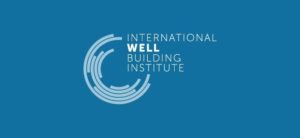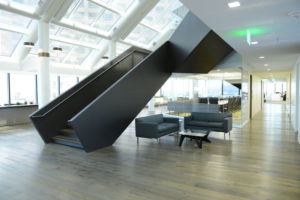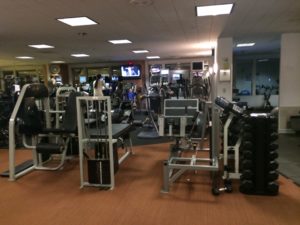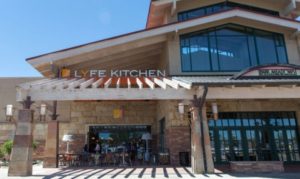Wellness at Work? WELL Certified

“We spend 90% of our time indoors.”
Introducing here…

The International Well Building Institute, a public benefit corporation, is a relatively new organization offering a voluntary 3rd-party performance-based certification of buildings in order to “[empower] the creation of healthy environments for people to live, work and play, enhancing occupant health and quality of life globally.”
“Our built environment can shape our habits and choices, regulate our sleep-wake cycle, drive us toward healthy and unhealthy choices, and passively influence our health through the quality of our surroundings.
“WELL provides a framework for project teams to incorporate a variety of strategies to integrate human health and well-being at the heart of building design, construction and operations. WELL also allows project teams to innovate and transform the way humans can interact with the buildings and spaces they live in. WELL allows people to connect with buildings.” (quotes: the WELL Brochure.)
WELL Certification is designed to complement other voluntary 3rd-party certification rating systems for buildings such as the by-now familiar LEED v4 (USGBC/GBCI) and the more rigorous and well-respected LBC 3.1 (ILFI).
The WELL rating system was first rolled out late 2014. LEED certification, 1994. LBC, 2006.
There are 7 concepts of WELL. For comparison purposes, there are 8 performance categories comprising LEED certification and 7, called “Petals,” for LBC:
| WELL v1 | LEED v4 | LBC 3.1 |
| Air | Location and Transportation | Place |
| Water | Sustainable Sites | Water |
| Nourishment | Water Efficiency | Energy |
| Light | Energy and Atmosphere | Health + Happiness |
| Fitness | Materials and Resources | Materials |
| Comfort | Indoor Environmental Quality | Equity |
| Mind | Innovation | Beauty |
| Regional Priority |
Apart from apparent and actual overlaps in categories of the several certification ratings (particular approaches to sustainable design/construction strategies will vary), one can easily see the WELL categories as indoor-related.Within these categories per rating system are individual preconditions and optimizations (WELL), prerequisites and credits (LEED) and imperatives (LBC).
One distinction is that WELL certification requires an on-site performance verification prior to final certification. In the LEED program, what’s called Fundamental Commissioning, a prerequisite, includes post-occupancy verification. Also, energy use and water consumption must be reported for 5 years post-occupancy. The LEED administrator is advised, generally, that post-occupancy site “audits” are performed occasionally and randomly across the spectrum of certified buildings. In LBC, projects must be operational for a minimum of 12 months before a final audit is performed.
For WELL, a WELL Assessor completes visual inspections to “verify documentation, and performance tests to evaluate air and water quality, noise, light and temperature levels, and other environmental parameters applicable to the preconditions and options claimed.” Once all requirements are met, the WELL AP™ (certification administrator) can proceed to final certification.
The first of the WELL Concepts is Air.
“Productivity improvements of 8-11% are not uncommon as a result of better air quality.” (Source: World Green Building Council.)
Of the various sources of indoor air quality concern, the majority source is inadequate ventilation at 52%. Contamination from within the building ranks 2nd; 16%. 13% comes from “unknown sources.”
For Water, the WELL Building Standard calls for proper filtration and treatment and regular testing to assure optimal quality. Hydration is, of course, promoted. In many, if not all, Baltimore City public schools, drinking water is provided from jugs brought in as the aged infrastructure of lead pipes is contaminated for human water consumption purposes. Finding cups is typically impossible. Besides, the much-better solution is personal water bottles, including quantity/gulp.
“The [WELL] Standard notes that being just 2% dehydrated can impair attention, psychomotor and immediate memory skills.
“Further, as much as 80% of the U.S. population goes through the typical day at least mildly dehydrated.” (Source: “Avoid Dehydration in the Workplace, Mike Marcovsky, ISHN, 2009.”)
Under the Fitness Concept, there’s a Fitness Feature Level Matrix. The first, Interior Fitness Circulation, includes 3 preconditions for new and existing buildings: Stair Accessibility; Stair Promotion; and, Facilitative Aesthetics.
What’s Facilitative Aesthetics? For 2-4 story projects, both stairways and commons paths should feature elements of aesthetic appeal such as abundant daylighting, music, artworks and high foot-candle illumination (min. 20 fc).
Another within Fitness is Activity Incentive Programs. Again for new and existing buildings and interiors, a minimum of two features are required. For one, tax-exempt payroll deductions for bicycle and mass transit commuting.
For another: “$200 or greater reimbursements or incentive payments in every 6-month period that an employee meets a 50-visit minimum to the gym or professional program.” Only a little more than twice/mo. Not much–easy. A final example of several more options: “A subsidy of at least $240 per year is available to each interested employee to cover the costs of participation in races, group fitness activities and sports teams.”
 Lobby Daylighting and Active Design at WELL Certified™ CBRE world HQ in LA.
Lobby Daylighting and Active Design at WELL Certified™ CBRE world HQ in LA.

For more general appreciation, if looking for a WELL Building Standard certified restaurant, visit one of these LYFE Kitchens. (If looking for a LEED® Gold restaurant, see my post about Founding Farmers in DC.)

More information about the WELL Building Standard is available at no charge after registering at the International WELL Building website, linked here. (In an appendix, which I did not reference, are comparisons between WELL, LEED and LBC.)